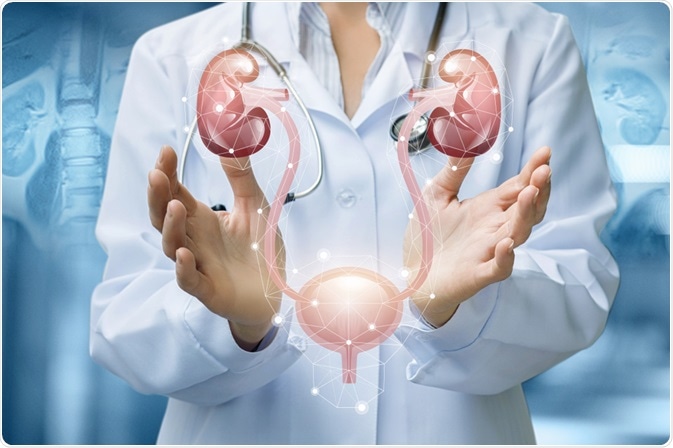Urinary incontinence is an extremely common health condition that involves the involuntary loss of urine. It can pose embarrassing situations for those affected, particularly in social and public situations. For this reason, adequate management of urinary incontinence is necessary.

Image Credit: Natali _ Mis / Shutterstock.com
There are several types of urinary continence that are caused by different factors. With this in mind, the type of urinary incontinence should be considered when making a clinical diagnosis in order to create an effective and individualized management plan.
Pelvic floor muscle training exercises
The pelvic floor muscles are found in the groin region and are able to stop the flow of urine voluntarily when contracting. Exercises can help to train and strengthen the muscles, which often helps to improve symptoms of incontinence.
Pelvic floor exercises are particularly useful for stress incontinence, which is more common after situations when these muscles have weakened, such as in women following childbirth. However, it may prove useful for all types of incontinence.
Bladder training
Using methods of bladder training, including voiding at regular intervals to help form a pattern, is often the best course of action for people suffering from urge and overflow incontinence. This helps to condition the muscles needed to urinate and trains them to urinate at the right time.
Diet and lifestyle
Obesity has been linked to a higher risk of urinary incontinence and, therefore, overweight and obese people who can lose weight are more likely to regain control over their symptoms.
Patients seeking to lose weight should monitor the size of their meal proportions and take care to limit the fat and sugar content of their food. In general, fresh fruit and vegetables are the best options, whereas highly processed foods should be avoided. At least 30 minutes of exercise should also be encouraged each day.
Additionally, the use of absorbent products can help to minimize the effect of incontinence symptoms and avoid embarrassing situations. In the ideal scenario, this option should be seen as a short-term solution while the cause is being addressed to manage the condition.
Medical management
Medications can offer a benefit in the treatment of urinary continence, particularly when there is a distinct cause, such as overactive bladder or a urinary tract infection (UTI).
Anticholinergic drugs are commonly used to inhibit the contraction of the detrusor muscles of an overactive bladder. This class of drugs provide effective results for urge incontinence, helping the bladder to contract only when the brain sends nerve signals to indicate that it is the right time to do so.
If a UTI is the cause of the symptoms, antibiotic medications such as trimethoprim are indicated to eradicate the infection. At the resolution of the infection, symptoms usually resolve.
Some hormonal medications, such as estrogen pessaries, may also offer a benefit to patients in certain cases. However, when taken for extended periods of time, these hormonal therapies can increase the risk of breast and endometrial cancer.
Electrical stimulation
The muscles of the urinary tract can be strengthened with the use of electrical stimulation to the lower pelvic area. Electrodes are temporarily placed in the vagina or rectum to stimulate muscular contraction, which can help patients to regain voluntary control of the muscles.
Biofeedback
Electronic devices or diaries can help patients to track the movements of the bladder and surrounding muscles. This increases awareness of bodily functions and can often helps patients with symptoms of stress and urge incontinence to regain control of urination.
Surgery
Surgery is generally seen as a last-line option and should only be recommended when all other treatment options have been exhausted. There are several types of surgery available for correcting urinary continence, including:
-
Bladder repositioning may be useful for women suffering from stress incontinence, which can be caused by movement of the urethra toward the vagina. Surgical procedures allow this to be repositioned to hold the bladder up and prevent leakage of urine.
-
Marshall-Marchetti-Krantz is a procedure for stress incontinence that involves the insertion of a catheter into the bladder to drain the urine, followed by stitches inserted to the bladder neck to support the area and help the patient gain control of urine flow.
-
A sling can be inserted to support the bladder and substitute for weak pelvic muscles in the treatment of stress incontinence. Comprised of a mesh material, the sling supports the urinary tract to successfully improve symptoms of incontinence.
-
Bladder augmentation is occasionally used to treat urinary incontinence. This procedure involves the insertion of an artificial urinary sphincter that old the bladder closed and can be manually opened by pressing a valve implanted under the skin.
-
Catheterization is an option for the treatment of overflow incontinence. This procedure allows the removal of urine from the body through the use of a catheter that empties the bladder. Long-term use of catheters is associated with a higher risk of UTIs; therefore, this adverse effect should be taken into consideration when choosing optimal treatment.
References
Further Reading
Last Updated: Mar 19, 2021